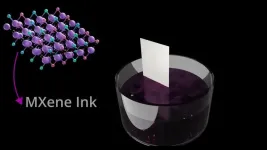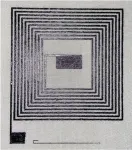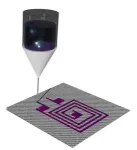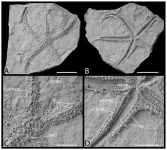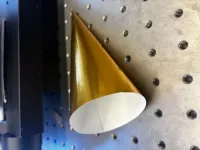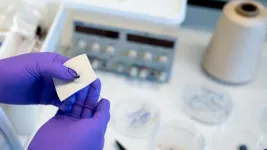(Press-News.org) The next step for fully integrated textile-based electronics to make their way from the lab to the wardrobe is figuring out how to power the garment gizmos without unfashionably toting around a solid battery. Researchers from Drexel University, the University of Pennsylvania, and Accenture Labs in California have taken a new approach to the challenge by building a full textile energy grid that can be wirelessly charged. In their recent study, the team reported that it can power textile devices, including a warming element and environmental sensors that transmit data in real-time.
Published in the journal Materials Today, the paper describes the process and viability of building the grid by printing on nonwoven cotton textiles with an ink composed of MXene, a type of nanomaterial created at Drexel, that is at that same time highly conductive and durable enough to withstand the folding, stretching and washing that clothing endures.
The proof-of-concept represents an important development for wearable technology, which at present requires complicated wiring and is limited by the use of rigid, bulky batteries that are not fully integrated into garments.
“These bulky energy supplies typically require rigid components that are not ideal for two main reasons,” said Yury Gogotsi, PhD, distinguished university and Bach professor in Drexel’s College of Engineering, who was a leader of the research. “First, they are uncomfortable and intrusive for the wearer and tend to fail at the interface between the hard electronics and the soft textile over time — an issue that is especially difficult to tackle for e-textiles is the issue of washability.”
By contrast, the team’s proposed textile grid was printed on a lightweight, flexible cotton substrate the size of a small patch. It includes a printed resonator coil, dubbed an MX-coil, that can convert electromagnetic waves into energy — enabling wireless charging; and a series of three textile supercapacitors — previously developed by Drexel and Accenture Labs — that can store energy and use it to power electronic devices.
The grid was able to wirelessly charge at 3.6 volts — enough to power not only wearable sensors, but also digital circuits in computers, or small devices, like wristwatches and calculators. Just 15 minutes of charging produced enough energy to power small devices for more than 90 minutes. And its performance barely diminished after an extensive series of bending and washing cycles to simulate the wear and tear exerted on clothing.
In addition to testing the grid with small electronic devices, collaborators from the University of Pennsylvania, led by Flavia Vitale, PhD, an associate professor of neurology, demonstrated that it can also power wireless MXene-based biosensor electrodes — called MXtrodes — that can monitor muscle movement.
“Beyond on-garment applications requiring energy storage, we also demonstrated use cases that may not require energy storage,” said Alex Inman, PhD, who helped to perform this research during his internship at Accenture Labs, while a doctoral student and research assistant with Gogotsi in the A.J. Drexel Nanomaterials Institute. “Situations with relatively sedentary users — an infant in a crib, or a patient in a hospital bed — would allow direct power applications, such as continuously wireless powered monitoring of movement and vital signs.”
In this vein, they also used the system to power an off-the-shelf array of temperature and humidity sensors and a microcontroller to broadcast the data they collected in real-time. A wireless charge of 30 minutes powered real-time broadcasts from the sensors — a relatively energy-intensive function — for 13 minutes.
And lastly, the team used the MX-coil to power a printed, on-textile heating element, called a Joule heater, that produced a temperature gain of about 4 degrees Celsius as a proof-of-concept.
“Many different technologies could be powered by wireless charging. The main thing to consider when picking an application is that it needs to make sense for a wearable application,” Gogotsi said. “We tend to think of biological sensors as a very enticing application because this is the future of health care. They can be integrated directly into textiles, increasing the quality and fidelity of the data and increasing user comfort. But our research shows that a textile-based power grid could power any number of peripheral devices: fiber-based LEDs for fashion or job safety, wearable haptics for AR/VR applications like job training and entertainment, and control external electronics when a stand-alone controller may be undesirable.”
The next step for developing this technology involves showing how the system could be scaled up without diminishing its performance or limiting its ability to be integrated into textiles. Gogotsi and Inman anticipate MXene materials holding the key to translating a variety of technology into textile form. Not only can MXene ink be applied to most common textile substrate, but a number of MXene-based devices have also been demonstrated as proofs-of-concept.
“We are producing enough power from the wireless charging to power a lot of different applications, so the next steps come down to integration,” Inman said. “One large way MXene can help with this is that it can be used for many of these functionalities —conductive traces, antennae and sensors, for example — and you do not have to worry about material mismatches that may cause electrical or mechanical failure.”
END
Off the clothesline, on the grid: MXene nanomaterials enable wireless charging in textiles
Researchers demonstrate printed textile-based energy grid using MXene ink
2024-10-31
ELSE PRESS RELEASES FROM THIS DATE:
How COVID-19 transformed family dinners
2024-10-31
WASHINGTON — While the lockdowns associated with the COVID-19 pandemic led many families to eat more meals at home, they had an additional benefit: an increase in the quality of family time during those dinners, according to research published by the American Psychological Association.
The study, published in the journal Couple and Family Psychology: Research and Practice, found that families who ate together more often during the pandemic also had more positive interactions, shared news and information, and even embraced technology such as videoconferencing ...
New ESO image captures a dark wolf in the sky
2024-10-31
For Halloween, the European Southern Observatory (ESO) reveals this spooktacular image of a dark nebula that creates the illusion of a wolf-like silhouette against a colourful cosmic backdrop. Fittingly nicknamed the Dark Wolf Nebula, it was captured in a 283-million-pixel image by the VLT Survey Telescope (VST) at ESO’s Paranal Observatory in Chile.
Found in the constellation Scorpius, near the centre of the Milky Way on the sky, the Dark Wolf Nebula is located around 5300 light-years from Earth. This image takes up an area in the sky equivalent to four full Moons, but is actually part of an even ...
New research reveals delayed evolutionary origin of Asteriidae sea stars
2024-10-31
A study published in PeerJ Life and Environment has reshaped our understanding of the evolutionary history of sea stars, particularly the family Asteriidae. The study, titled Phylogenetic and taxonomic revisions of Jurassic sea stars support a delayed evolutionary origin of the Asteriidae, introduces new findings that challenge longstanding assumptions about the evolutionary timeline of these marine invertebrates.
Sea stars of the superorder Forcipulatacea, comprising approximately 400 species, are integral ...
A paper-aluminum combo for strong, sustainable packaging
2024-10-31
Takeout containers get your favorite noodles from the restaurant to your dining table (or couch) without incident, but they are nearly impossible to recycle if they are made from foil-lined plastics. Research published in ACS Omega suggests that replacing the plastic layer with paper could create a more sustainable packaging material. The researchers used mechanical demonstrations and computer simulations to identify paper-aluminum laminate designs that won’t compromise on performance.
Protective packaging, like containers made ...
A novel neural network for preserving cultural heritage via 3D image reconstruction
2024-10-31
Relief carvings or relief sculptures are cultural heritage objects with figures that protrude from a background such as a wall or slab, creating a sense of depth. Commonly found at historical sites worldwide, these artworks are considered to be of immense historical and cultural value. Unfortunately, many such relief carvings at heritage sites across the world suffer from varying degrees of damage and deterioration over time. While modern 3D scanning and photogrammetry techniques can digitally preserve their current form, they cannot restore the original appearance of these carvings before damage. Additionally, traditional methods for restoring ...
Sleep apnea contributes to dementia in older adults, especially women
2024-10-31
A common yet underdiagnosed sleep disorder contributes to the development of dementia among adults — particularly women, a Michigan Medicine study suggests.
Investigators uncovered this by examining survey and cognitive screening data from more than 18,500 adults to determine the potential effect of known or suspected obstructive sleep apnea on the risk for dementia.
Obstructive sleep apnea is a chronic sleep disorder characterized by episodes disrupted or restricted breathing during sleep.
For all adults age 50 and older, having known obstructive sleep apnea or its symptoms — as people often do not know they have the problem ...
The silk thread that can turn clothes into charging stations
2024-10-31
Imagine a sweater that powers electronics to monitor your health or charge your mobile phone while running. This development faces challenges because of the lack of materials that both conduct electricity stably and are well suited for textiles. Now a research group, led by Chalmers University of Technology in Sweden, presents an ordinary silk thread, coated with a conductive plastic material, that shows promising properties for turning textiles into electricity generators.
Thermoelectric textiles convert temperature differences, for example between our bodies and the surrounding ...
Glaucoma drug shows promise against neurodegenerative diseases, animal studies suggest
2024-10-31
A drug commonly used to treat glaucoma has been shown in zebrafish and mice to protect against the build-up in the brain of the protein tau, which causes various forms of dementia and is implicated in Alzheimer’s disease.
Researchers in the UK Dementia Research Institute at the University of Cambridge screened more than 1,400 clinically-approved drug compounds using zebrafish genetically engineered to make them mimic so-called tauopathies. They discovered that drugs known as carbonic anhydrase inhibitors – of which the glaucoma drug methazolamide is one – clear tau build-up and reduce signs of the disease in zebrafish and mice carrying the mutant forms of tau ...
Human proteins identified that explain inter-individual differences in functional brain connectivity
2024-10-31
BIRMINGHAM, Ala. – A long-standing goal of neuroscience is to understand how molecules and cellular structures on a microscale give rise to communication between brain regions at the macroscale. A study published in Nature Neuroscience now identifies, for the first time, hundreds of brain proteins that explain inter-individual differences in functional connectivity and structural covariation in the human brain.
“A central goal of neuroscience is to develop an understanding of the brain that ultimately describes the mechanistic basis of human cognition and behavior,” said Jeremy Herskowitz, Ph.D., associate professor in the University of Alabama at Birmingham ...
A newly developed algorithm shows how a gene is expressed at microscopic resolution
2024-10-31
They say a picture is worth a thousand words.
A new method, developed by University of Michigan researchers, creates images that are worth many gigabytes of data, which could revolutionize the way biologists study gene expression. Seq-Scope, developed by Jun Hee Lee, Ph.D., Hyun Min Kang, Ph.D., and their colleagues, was first described in Cell in 2021 as the first method to analyze gene expression at sub micrometer-scale spatial resolution.
To compare, a single human hair ranges from 20 to 200 micrometers in width.
The team has since improved Seq-Scope, making it more versatile, ...
LAST 30 PRESS RELEASES:
Interaction of climate change and human activity and its impact on plant diversity in Qinghai-Tibet plateau
From addressing uncertainty to national strategy: an interpretation of Professor Lim Siong Guan’s views
Clinical trials on AI language model use in digestive healthcare
Scientists improve robotic visual–inertial trajectory localization accuracy using cross-modal interaction and selection techniques
Correlation between cancer cachexia and immune-related adverse events in HCC
Human adipose tissue: a new source for functional organoids
Metro lines double as freight highways during off-peak hours, Beijing study shows
Biomedical functions and applications of nanomaterials in tumor diagnosis and treatment: perspectives from ophthalmic oncology
3D imaging unveils how passivation improves perovskite solar cell performance
Enriching framework Al sites in 8-membered rings of Cu-SSZ-39 zeolite to enhance low-temperature ammonia selective catalytic reduction performance
AI-powered RNA drug development: a new frontier in therapeutics
Decoupling the HOR enhancement on PtRu: Dynamically matching interfacial water to reaction coordinates
Sulfur isn’t poisonous when it synergistically acts with phosphine in olefins hydroformylation
URI researchers uncover molecular mechanisms behind speciation in corals
Chitin based carbon aerogel offers a cleaner way to store thermal energy
Tracing hidden sources of nitrate pollution in rapidly changing rural urban landscapes
Viruses on plastic pollution may quietly accelerate the spread of antibiotic resistance
Three UH Rainbow Babies & Children’s faculty elected to prestigious American Pediatric Society
Tunnel resilience models unveiled to aid post-earthquake recovery
Satellite communication systems: the future of 5G/6G connectivity
Space computing power networks: a new frontier for satellite technologies
Experiments advance potential of protein that makes hydrogen sulfide as a therapeutic target for Alzheimer’s disease
Examining private equity’s role in fertility care
Current Molecular Pharmacology achieves a landmark: real-time CiteScore advances to 7.2
Skeletal muscle epigenetic clocks developed using postmortem tissue from an Asian population
Estimating unemployment rates with social media data
Climate policies can backfire by eroding “green” values, study finds
Too much screen time too soon? A*STAR study links infant screen exposure to brain changes and teen anxiety
Global psychiatry mourns Professor Dan Stein, visionary who transformed mental health science across Africa and beyond
KIST develops eco-friendly palladium recovery technology to safeguard resource security
[Press-News.org] Off the clothesline, on the grid: MXene nanomaterials enable wireless charging in textilesResearchers demonstrate printed textile-based energy grid using MXene ink
